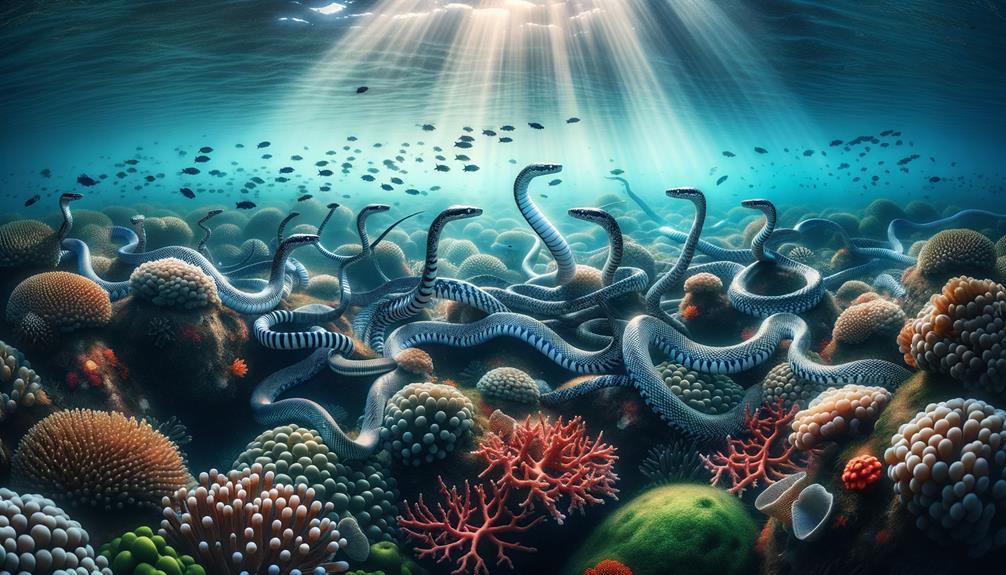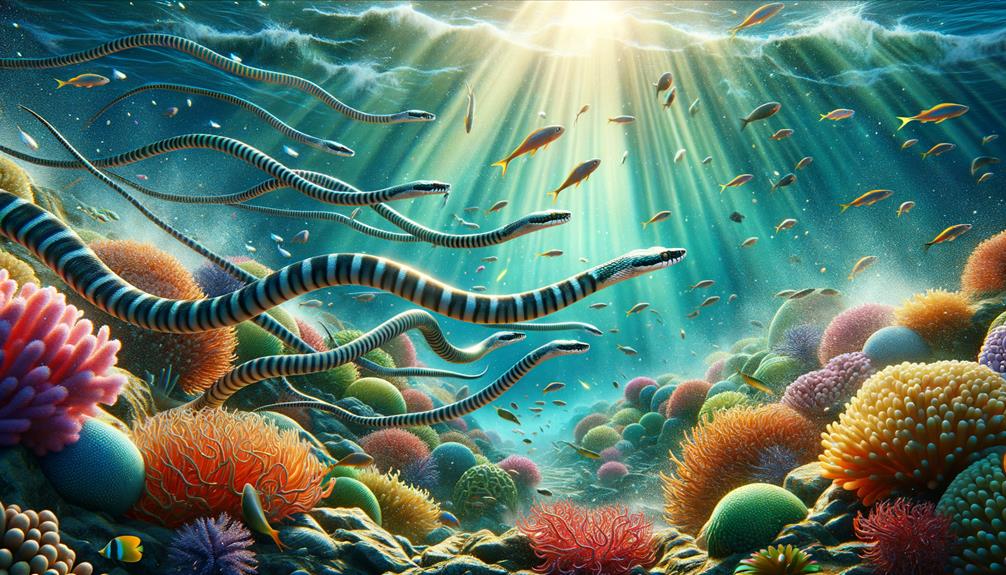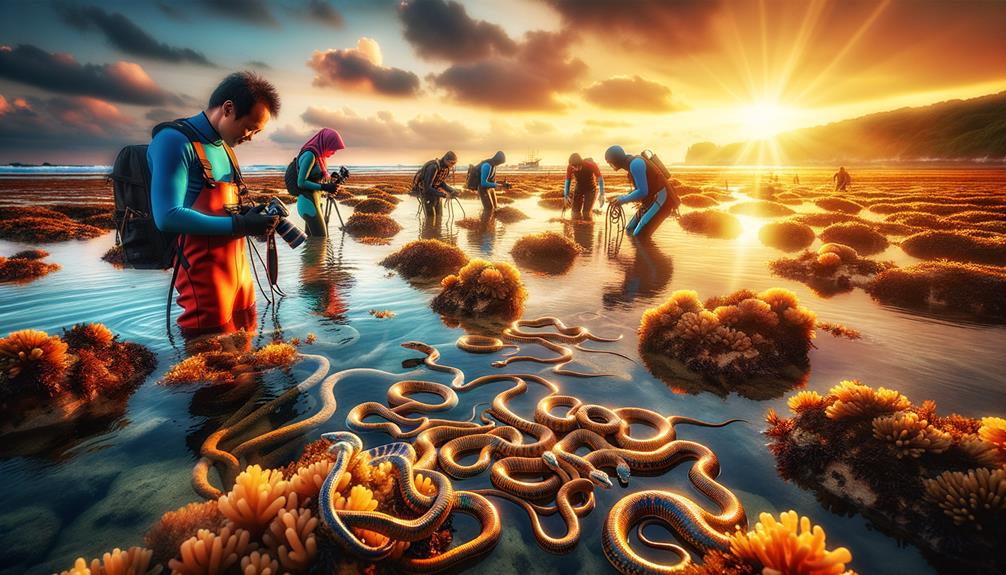When you watch sea kraits, especially the banded ones, you'll notice they're right at home in the areas where land meets sea. These snakes are pros at moving between dry ground and water. They've got special glands that help them deal with changing salt levels, which is pretty handy in their back-and-forth lifestyle.
These coastal spots aren't just where sea kraits hang out – they're key for breeding, grabbing a bite, and taking a breather. If we want to keep these critters around, we need to get a handle on how they behave and what they need in these areas.
What really gets me excited is how their life cycle fits into these ever-changing coastal ecosystems. There's still a lot to learn about that connection, and I think it's worth digging into more.
Habitat and Distribution
Sea kraits make their home in shallow tropical waters, from coral reefs to mangrove swamps. These unique reptiles split their time between land and sea, often spotted along sandy beaches and coral islands. You'll find them in coastal areas around New Guinea, various Pacific islands, the Philippines, southeast Asia, Sri Lanka, and Japan. The banded sea krait is particularly common in these intertidal zones.
These snakes have some clever adaptations for their dual lifestyle. Their large belly scales give them grip on wet and dry surfaces, making it easy to move between water and land. They've also got special salt glands under their tongues that help them get rid of excess salt – a handy trick for living in seawater.
While sea kraits are found across a wide area, they stick to warm, shallow coastal waters. These spots offer everything they need: food, rest, and breeding grounds. By looking at where sea kraits live and how they've adapted, we can better understand their role in coastal ecosystems. It also highlights why it's so important to protect these intertidal areas to ensure these fascinating creatures can continue to thrive.
Behavioral Patterns

Sea kraits display intriguing habits that showcase their adaptability to both land and sea. These marine snakes, often spotted in coastal areas, make regular trips ashore roughly every 10 days. These land visits serve various purposes, including digestion, mating, egg-laying, and shedding skin. During breeding season, their onshore activity ramps up as they search for mates and engage in complex courtship behaviors.
These reptiles have unique features that help them thrive in their dual habitats. Large scales on their bellies aid in land movement and even allow them to climb trees near the shore. They also have special nose valves and tightly-fitting mouth scales that prevent water from entering when submerged.
A quick overview of their key behaviors:
| Activity | Habit |
|---|---|
| Digestion | Shore visits every 10 days |
| Mating | Increased land activity during breeding times |
| Egg-laying | Frequent shore visits |
| Adaptations | Belly scales, nose valves, water-tight mouth |
Interestingly, banded sea kraits have a remarkable way of dealing with excess salt. They drink fresh water on land and expel the salt through a special gland under their tongue. This wide range of behaviors highlights how well these marine snakes have adapted to life between land and sea in coastal zones.
Diet and Hunting

Sea kraits are skilled night hunters that mainly go after eels in the shallow waters and nooks of coral reefs near the shore. Their hunting habits show an interesting split: females often target conger eels, while males usually chase moray eels. This choice in prey helps keep things balanced in their environment, cutting down on competition within their own kind.
These sea snakes use their potent venom to quickly stop eels in their tracks. The venom works fast, paralyzing the eel's muscles almost right away. This lets sea kraits eat their catch without much of a fight. While they prefer eels, they're not picky eaters and will sometimes snag small fish stuck in reef cracks.
Sea kraits have some impressive tricks up their sleeves for hunting underwater. They can swim down to 80 meters, which gives them a lot of options for finding food in different places. The areas where sea meets land, full of twisting coral reefs, are perfect hunting grounds with loads of potential meals. By being active at night, they face fewer threats and can use the darkness to their advantage when looking for food.
Breeding and Lifecycle

Banded sea kraits embark on impressive journeys to specific land-based mating spots during breeding season. They gather in large numbers on small islands, where males engage in complex courtship behaviors. These include forming tight clusters around females ready to mate, ensuring successful reproduction in these crowded conditions.
These snakes can breed multiple times throughout their lives, laying eggs each time. After mating, females search for protected nooks to deposit their eggs. These spots must shield the eggs from predators and provide suitable conditions for incubation, playing a crucial role in offspring survival.
Land activity ramps up significantly during this period. Snakes spend more time on shore for mating, egg-laying, and shedding their skin. This skin-shedding process is vital for the kraits' health and supports their reproductive efforts. Often, the snakes shed their old skin while engaged in these breeding activities, ensuring they're in top form for the challenges ahead.
Conservation Efforts

Protecting the habitats of banded sea kraits has become a top concern for wildlife experts. Their focus now lies on preserving coral reefs, mangrove swamps, and sandy beaches – all crucial for these unique creatures. These actions aim to counter the damage caused by human activity and maintain the complex web of life in these areas.
Tracking sea krait populations helps researchers understand their habits and numbers. This information guides more effective protection strategies. Cutting down on pollution and keeping these coastal zones intact are key parts of ongoing conservation work.
Teaching the public about why these areas matter is just as crucial. When people understand how important these zones are for sea kraits and other marine life, they're more likely to support protection efforts. Success depends on teamwork between government bodies, conservation groups, and local communities.
All these steps work together to keep coastal ecosystems healthy, giving banded sea kraits and their neighbors a fighting chance. By keeping a close eye on these areas and teaching others about them, we can help ensure these fascinating sea snakes have a future.
Frequently Asked Questions
Where Is the Sea Krait Found?
Sea kraits are fascinating creatures you'll spot in the coastal waters of the Pacific and Indian Oceans. These snakes thrive in warm, tropical, and subtropical areas. You'll often see them hanging out in coral reefs, mangrove swamps, and along sandy beaches or rocky shorelines. These spots are perfect for their hunting and nesting activities. If you're lucky enough to visit these regions, keep an eye out for these unique marine reptiles as they navigate their coastal habitats.
What Ocean Zone Do Sea Snakes Live In?
Sea snakes make their home in the intertidal zone, a surprising choice for these aquatic reptiles. They thrive in warm, shallow waters around coral reefs and mangrove swamps. These adaptable creatures move easily between land and sea, showcasing their remarkable ability to survive in varied environments. Their presence in these coastal areas highlights the complex relationship between marine and terrestrial ecosystems.
What Subfamily Is the Sea Kraits In?
Sea kraits are part of the Laticaudinae subfamily, which falls under the Elapidae family. These snakes are fascinating because they have both land and sea characteristics. Scientists find them particularly interesting to study since they show how animals can adapt to different environments over time.
What Is the Difference Between a Sea Snake and a Sea Krait?
Sea kraits are quite remarkable, spending about half their lives on dry land, in contrast to sea snakes, which are fully aquatic. Their behavior is intriguing – they come ashore to lay eggs, while sea snakes give birth to live young in the water. This adaptability allows sea kraits to thrive in both environments, showcasing nature's diverse survival strategies.



